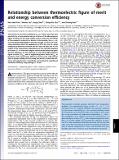| dc.contributor.author | Kim, Hee Seok | |
| dc.contributor.author | Liu, Weishu | |
| dc.contributor.author | Chen, Gang | |
| dc.contributor.author | Chu, Ching-Wu | |
| dc.contributor.author | Ren, Zhifeng | |
| dc.date.accessioned | 2016-02-05T12:37:20Z | |
| dc.date.available | 2016-02-05T12:37:20Z | |
| dc.date.issued | 2015-07 | |
| dc.date.submitted | 2015-04 | |
| dc.identifier.issn | 0027-8424 | |
| dc.identifier.issn | 1091-6490 | |
| dc.identifier.uri | http://hdl.handle.net/1721.1/101109 | |
| dc.description.abstract | A multiwavenumber theory is formulated to represent eddy diffusivities. It expands on earlier single-wavenumber theories and includes the wide range of wavenumbers encompassed in eddy motions. In the limiting case in which ocean eddies are only composed of a single wavenumber, the multiwavenumber theory is equivalent to the single-wavenumber theory and both show mixing suppression by the eddy propagation relative to the mean flow. The multiwavenumber theory was tested in a region of the Southern Ocean (70°–45°S, 110°–20°W) that covers the Drake Passage and includes the tracer/float release locations during the Diapycnal and Isopycnal Mixing Experiment in the Southern Ocean (DIMES). Cross-stream eddy diffusivities and mixing lengths were estimated in this region from the single-wavenumber theory, from the multiwavenumber theory, and from floats deployed in a global k[subscript 0]° Parallel Ocean Program (POP) simulation. Compared to the single-wavenumber theory, the horizontal structures of cross-stream mixing lengths from the multiwavenumber theory agree better with the simulated float-based estimates at almost all depth levels. The multiwavenumber theory better represents the vertical structure of cross-stream mixing lengths both inside and outside the Antarctica Circumpolar Current (ACC). Both the single-wavenumber and multiwavenumber theories represent the horizontal structures of cross-stream diffusivities, which resemble the eddy kinetic energy patterns. | en_US |
| dc.description.sponsorship | United States. Dept. of Energy (Contract DOE DE-FG02-13ER46917/DE-SC0010831) | en_US |
| dc.description.sponsorship | United States. Dept. of Energy. Office of Science (Solid-State Solar-Thermal Energy Conversion Center Award DE-SC0001299) | en_US |
| dc.description.sponsorship | United States. Air Force Office of Scientific Research (Grant FA9550-09-1-0656) | en_US |
| dc.description.sponsorship | Templeton Foundation | en_US |
| dc.description.sponsorship | John J. and Rebecca Moores Endowment | en_US |
| dc.description.sponsorship | University of Houston. Texas Center for Superconductivity | en_US |
| dc.language.iso | en_US | |
| dc.publisher | National Academy of Sciences (U.S.) | en_US |
| dc.relation.isversionof | http://dx.doi.org/10.1073/pnas.1510231112 | en_US |
| dc.rights | Article is made available in accordance with the publisher's policy and may be subject to US copyright law. Please refer to the publisher's site for terms of use. | en_US |
| dc.source | National Academy of Sciences (U.S.) | en_US |
| dc.title | Relationship between thermoelectric figure of merit and energy conversion efficiency | en_US |
| dc.type | Article | en_US |
| dc.identifier.citation | Kim, Hee Seok, Weishu Liu, Gang Chen, Ching-Wu Chu, and Zhifeng Ren. “Relationship Between Thermoelectric Figure of Merit and Energy Conversion Efficiency.” Proc Natl Acad Sci USA 112, no. 27 (June 22, 2015): 8205–8210. © 2015 American Meteorological Society | en_US |
| dc.contributor.department | Massachusetts Institute of Technology. Department of Mechanical Engineering | en_US |
| dc.contributor.mitauthor | Chen, Gang | en_US |
| dc.relation.journal | Proceedings of the National Academy of Sciences | en_US |
| dc.eprint.version | Final published version | en_US |
| dc.type.uri | http://purl.org/eprint/type/JournalArticle | en_US |
| eprint.status | http://purl.org/eprint/status/PeerReviewed | en_US |
| dspace.orderedauthors | Kim, Hee Seok; Liu, Weishu; Chen, Gang; Chu, Ching-Wu; Ren, Zhifeng | en_US |
| dc.identifier.orcid | https://orcid.org/0000-0002-3968-8530 | |
| mit.license | PUBLISHER_POLICY | en_US |
| mit.metadata.status | Complete | |
